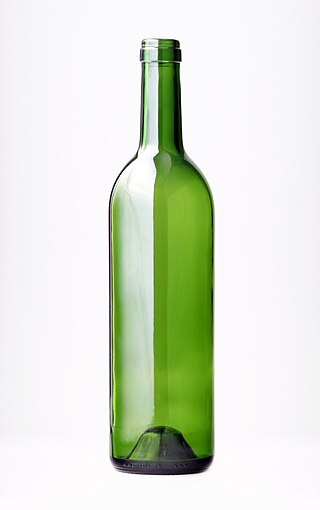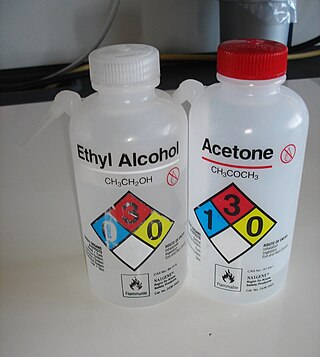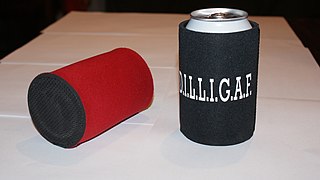
A vacuum flask is an insulating storage vessel that greatly lengthens the time over which its contents remain hotter or cooler than the flask's surroundings. Invented by Sir James Dewar in 1892, the vacuum flask consists of two flasks, placed one within the other and joined at the neck. The gap between the two flasks is partially evacuated of air, creating a near-vacuum which significantly reduces heat transfer by conduction or convection. When used to hold cold liquids, this also virtually eliminates condensation on the outside of the flask.

A thermoplastic, or thermosoftening plastic, is any plastic polymer material that becomes pliable or moldable at a certain elevated temperature and solidifies upon cooling.

A bottle is a narrow-necked container made of an impermeable material in various shapes and sizes that stores and transports liquids. Its mouth, at the bottling line, can be sealed with an internal stopper, an external bottle cap, a closure, or induction sealing.

A bottle cap or bottle top is a closure for the top opening of a bottle. A cap is sometimes colorfully decorated with the logo of the brand of contents. Plastic caps are used for plastic bottles, while metal with plastic backing is used for glass; plastic caps are commonly made from polyethylene or polypropylene, while metal caps are usually either steel or aluminum. Plastic caps may have a pour spout. Flip-Top caps like Flapper closures provide controlled dispensing of dry products. Caps for plastic bottles are often made of a different type of plastic from the bottle.

A reusable bottle is a bottle that can be reused, as in the case as by the original bottler or by end-use consumers. Reusable bottles have grown in popularity by consumers for both environmental and health safety reasons. Reusable bottles are one example of reusable packaging.

A mug is a type of cup typically used for drinking hot drinks, such as coffee, hot chocolate, or tea. Mugs usually have handles and hold a larger amount of fluid than other types of cups. Typically, a mug holds approximately 240–350 ml of liquid. A mug is a less formal style of drink container and is not usually used in formal place settings, where a teacup or coffee cup is preferred. Shaving mugs are used to assist in wet shaving.

A water dispenser, known as water cooler, is a machine that dispenses and often also cools or heats up water with a refrigeration unit. It is commonly located near the restroom due to closer access to plumbing. A drain line is also provided from the water cooler into the sewer system.

Nalgene is a brand of plastic products developed originally for laboratory use, including items such as jars, bottles, test tubes, and Petri dishes, that were shatterproof and lighter than glass. The properties of plastic products make them suitable for work with many substances in various temperature ranges.

A curtain wall is an exterior covering of a building in which the outer walls are non-structural, instead serving to protect the interior of the building from the elements. Because the curtain wall façade carries no structural load beyond its own dead load weight, it can be made of lightweight materials. The wall transfers lateral wind loads upon it to the main building structure through connections at floors or columns of the building.

A cooler, portable ice chest, ice box, cool box, chilly bin, or esky (Australia) is an insulated box used to keep food or drink cool.

A water bottle is a container that is used to hold liquids, mainly water, for the purpose of transporting a drink while travelling or while otherwise away from a supply of potable water.
Tiger Corporation is a Japanese manufacturer that applies vacuum insulation and heat control technology to consumer electronic appliances. Their headquarters are located in Kadoma City in Osaka, Japan. The company manufactures and sells appliances such as household and commercial vacuum insulated containers and stainless-steel bottles, along with cooking appliances such as rice cookers. The company also manufactures industrial parts and products used in automobiles, homes, air conditioners, space, and medical care in 60 countries around the world.

Building insulation materials are the building materials that form the thermal envelope of a building or otherwise reduce heat transfer.

A plastic bottle is a bottle constructed from high-density or low density plastic. Plastic bottles are typically used to store liquids such as water, soft drinks, motor oil, cooking oil, medicine, shampoo, milk, and ink. The size ranges from very small bottles to large carboys. Consumer blow molded containers often have integral handles or are shaped to facilitate grasping.

An aluminum bottle is a bottle made of aluminum. In some countries, it is also referred to as a 'bottlecan'. It is a bottle made entirely of aluminium that holds any kind of drink.

A koozie (US) or stubby holder (Australian) is a fabric or foam sleeve that is designed to thermally insulate a beverage container, like a can or bottle.

A canteen is a reusable drinking water bottle designed to be used by hikers, campers, soldiers, bush firefighters, and workers in the field. It is usually fitted with a shoulder strap or means for fastening it to a belt, and may be covered with a cloth bag and padding to protect the bottle and insulate the contents. If the padding is soaked with water, evaporative cooling can help keep the contents of the bottle cool. Many canteens also include a nested canteen cup.
Tervis Tumbler Company is an American manufacturer of double-walled, insulated tumblers. The double-wall insulation is made by inserting a liner inside an outer shell, creating a layer of air between them. The two liners are then permanently fused together. The insulation reduces condensation and keeps beverages hotter or colder longer than non-insulated cups and glasses.

Insulating glass (IG) consists of two or more glass window panes separated by a space to reduce heat transfer across a part of the building envelope. A window with insulating glass is commonly known as double glazing or a double-paned window, triple glazing or a triple-paned window, or quadruple glazing or a quadruple-paned window, depending upon how many panes of glass are used in its construction.




















